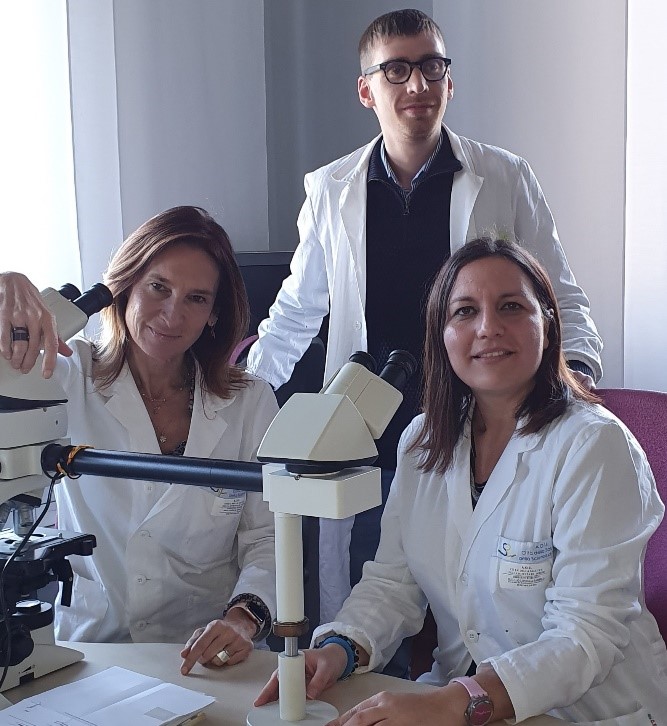
Q&A with Paola Cassoni, M.D., Ph.D. on Understanding the Pathway to Organ Rejection.
Turin is a lovely Italian city situated between the western and northern borders of Italy by the Alps, looking east at the Monferrato Hills. The Mole Antonelliana, the proud city symbol, has been watching over its citizens since 1889. Turin is a major economic center, rich in history and traditions. It is also the home of the Turin Renal Transplant Center, one of the best and the largest transplant facilities in Italy, having carried out over 3,600 transplants since it opened its doors in 1981. Prof. Paola Cassoni ─ seen in the picture below on the left, along with Dr. Bertero, seen standing above, and Dr. Barreca to the right and their colleagues are one of the winners of our Human Organ Transplant Panel grant program, and we had the pleasure to talk with her about her lab, research, and achievements.

NSTG: Professor Cassoni, you have quite a CV! You got your medical degree, then specialized in OB-GYN, got your doctorate in human oncology, and another specialization in pathology. What made you decide to branch out from OB-GYN to pathology?
PC: When I started my oncology doctoral program (after my specialty in OB-GYN), I did my research within a pathology unit. I suddenly fell in love with the extraordinary opportunity that pathology offers: human tissues are the ultimate place where answers to clinical questions can be investigated and found. Moreover, pathology diagnostics is continuously evolving with endless challenges: the perfect place for a curious person like me with no way to get bored even in everyday activities!
NSTG: What is your lab’s research interest?
PC: I lead a very multi-disciplinary team: our interests are focused on five areas, represented by gastrointestinal and breast pathology, neuropathology, and dermatopathology, with a special focus on melanoma and digital pathology. As a pathology unit, our aim is always to improve the relevance and quality of the information we can give to our clinicians, thus, helping improve patients’ care. We are very interested in identifying novel prognostic and predictive markers based either on morphological characteristics or through innovative “-omic” approaches.
Transplant pathology has always intrigued me, and now we are ready to add it to our research focus, strengthening our efforts in this interesting and demanding field.
NSTG: What sparked your interest in kidney transplants?
PC: Overall, transplant pathology is a very interesting field from a scientific point of view with many open questions. The moment we focused our attention on transplants, we immediately realized there is a huge unmet clinical need since the management of patients undergoing transplantation is extremely challenging. A deeper understanding of the molecular mechanisms behind graft dysfunction and rejection can really improve the outcome and quality of life of these patients. We decided to focus on kidney transplantation because our center has a long tradition in nephropathology, and there is a long-standing kidney transplant program.
NSTG: Your research proposal for the NanoString grant aims to understand the cause of antibody-mediated kidney organ rejection. Can you explain to our readers what chronic antibody-mediated rejection is and what causes it?
PC: Chronic antibody-mediated rejection (cABMR) is the major cause of late kidney transplant failure, and it represents a form of chronic allograft injury due to donor-specific antibodies (DSA), particularly anti-class II HLA DSA. These antibodies react with the endothelium, especially that of glomerular and peritubular capillaries, leading to recurrent cycles of endothelial activation and injury. This chronic damage leads to basement membrane multilayering as a repair mechanism and finally results in organ dysfunction.
NSTG: In your preliminary studies, Caveolin seems to be a major player in cABMR. How did you and your team discover this gene’s involvement in cABMR? What does this protein do?
PC: In 2007, Yamamoto et al. evaluated ultrastructural features of the glomerular capillary endothelium in patients with chronic transplant glomerulopathy and demonstrated that caveolae formation is strongly increased in the endothelium of glomerular capillaries. Caveolae are 50-100 nm flask-shaped specialized invaginated microdomains of the plasma membrane and are mainly constituted by the protein Caveolin-1 (Cav-1). Cav-1 has been described to be overexpressed in cABMR-injured endothelial cells, and in fact, it is one of the genes included in the molecular cABMR assessment from the latest Banff Classification 2017.
NSTG: The Turin Renal Transplant Center is one of the largest and most well-known transplant centers in Italy. Because the center has been open since 1981 and approximately 3,600 transplants have been carried out since you have access to a rich repository of serial biopsies collected throughout the treatment of individual patients. How do you think this repository will help you address research questions with this grant?
PC: The first reason is that the more comprehensive the repository is, the wider the range of open issues you can effectively tackle. For example, addressing rarer conditions or assessing the role of multiple variables such as clinical treatments. Moreover, the availability of well-characterized cohorts of patients is mandatory to draw reliable conclusions that can be translated into clinical practice. Obviously, every patient has his/her own story, but collecting all these data together allows us to have a complete overview of kidney transplant pathology so that we can infer what are the main problems and issues and then try to develop solutions for them.
The second reason is maybe less measurable but equally necessary, and it concerns the importance of working within an effective multidisciplinary team. A good renal transplant center needs to have close cooperation between the care team, pathology lab, and researchers, and this approach allows us to provide the best clinical care as well as to develop innovative research protocols in a collaborative manner. Here in Turin, we are very lucky to have such a close team, and this surely represents an added value for the present project.
NSTG: How did you hear about NanoString?
PC: We first heard about NanoString some years ago when we were evaluating innovative options to expand upon our range of molecular assays for diagnostics and research. The capability to investigate wide panels of molecular targets immediately interested us as well as the relatively simple “wet” lab workflow.
NSTG: What made you decide to use NanoString panels for your research on organ rejection?
PC: My research interests cover several areas; thus, a versatile platform like NanoString immediately piqued my interest. For instance, the last few years have witnessed an ever-increasing interest in studying the tumor microenvironment to uncover biomarkers that correlated with tumor immunotolerance or immunotherapy: NanoString panels were and are very effective in addressing these research topics, including organ rejection. Another development that is very interesting for us pathologists is the GeoMx® Digital Spatial Profiler (DSP). The correlation of spatial profiling to bulk gene expression analysis is critical for understanding a complete picture of biology, and it is also very similar to our daily diagnostic activity in pathology, where we correlate morphological characteristics with tumor classification and prognosis. DSP could really represent a new kind of “microscope”, allowing us to observe molecular hallmarks in organ rejection!
NSTG: How do you expect the NanoString technology to help you advance your research?
PC: NanoString has already allowed us to perform effective research projects, for example, investigating the melanoma immune microenvironment. Our results are now being published, and we are also designing new studies covering our research interests, including breast pathology and neuropathology. This has been made possible by the versatility of NanoString gene expression panels.
NSTG: Let’s take our conversation back to the Transplant Center’s repository: it seems the perfect scenario for the groundbreaking, sample-saving capabilities of GeoMx DSP. Do you see yourself and your team using it to decipher the mechanisms of rejection?
PC: Sure, GeoMx DSP is a great tool to help understand the “raw” molecular findings, for example, allowing us to specifically localize different expression signatures within a tissue. This is of paramount importance for transplant pathology, considering that organ rejection can arise through different mechanisms/pathways and involves different structures. We envision first investigating what are the key players involved in a specific rejection mechanism and then assessing, through GeoMx DSP, the cell types and structures involved. The chance given by DSP technology to add morphological context to our NanoString results is of extraordinary utility in this and other research settings.
NSTG: We like to conclude our interview with a light question about your colleagues in the lab. What makes your lab the best and most fun team? Do you have any fun stories that you can share?
PC: I think that the greatest strength of my team is everyone’s attitude: their willingness to collaborate, push things forward, be open to innovations while also keeping the pressure under control, and never forgetting to enjoy what we are doing. Research should first start from curiosity, the need to answer open questions, and thus should be something more than a job. Nevertheless, doing research in a clinical setting can be quite demanding at times because there is also the clinical activity and other duties, but it is always inspiring, and I would never give it up. Having a great team is surely the greatest luck I can possibly have, and we look forward to starting this grant project together!
If you want to read more about this, check out their latest paper!
For more information on the capabilities of the 770-plex Human Organ Transplant Panel and how it can help you decipher the biological content driving organ rejection of transplant biopsies and other challenging samples, check out the panel webpage.
For Research Use Only. Not for use in Diagnostic Procedures.


